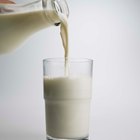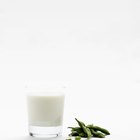
All milk substitutes, including rice, almond and soy milk, have a pretty reasonable shelf life. In most cases, this time is similar to the shelf life of shelf-stable cow milk. Soy milk is a good option for those who are lactose intolerant and cannot digest regular milk. There are also enough variants in terms of flavor and shelf life to fit all tastes and lifestyles.
Unopened Packages
Most soy milk comes in aseptic packaging. These are boxes sealed airtight that don’t require refrigeration. The average shelf life of unopened boxes of soy milk is about six months from the date of production. However, since it can take months for the product to actually reach the market, it’s important that you check the date on the label to ensure you’re buying soy milk that is not too close to the expiration date. Some companies sell refrigerated soy milk in containers that aren’t airtight. These have a much shorter shelf life, sometimes as little as a week from the time of bottling or packaging.
Open Packs
Once you open an airtight container of soy milk, you then have about a week to drink it, depending on the brand. Open boxes should stay in the refrigerator. According to the official website for Silk, a soy milk brand, soy milk can remain fresh for more than 10 days after the package is opened. However, the company only guarantees freshness and even flavor and texture for up to 10 days. If you plan on keeping it longer than that, try a small amount first to ensure it tastes O.K.
Dry Soy Milk
Powdered soy milk has the longest shelf life and might be a good choice for those who only drink it occasionally. Again, shelf life depends on brand, but it’s not rare for dry soy milk to last a year or more.
Variations
Freezing might extend the shelf life of soy milk, but most companies don’t recommend it. This is because freezing completely changes the texture of the milk. Although it’s safe to freeze soy milk, when you thaw it, water and soy are likely to separate. The ingredients don’t mix well again, affecting the look, texture and flavor of the milk.
Related Articles

Can You Drink Milk That Expires the ...

How to Freeze Goat's Milk

How to Purchase Milk Crates

What Are the Dangers of Out of Date ...

How to Store Discontinued Lipstick for ...

Can I Freeze Milkshakes?

Does Baking Soda Need to Be ...

Why Does Milk Freeze in the ...

How to Store Powdered Milk for ...

How to Tell If Coral Jewelry Is Real
How Long Before a Hard Boiled Egg Goes ...

Can I Dilute Whipping Cream to Sub Milk?

Why Does Greek Yogurt Have More Protein ...

How to Tell If a Guess Item Is Real?

Do You Have to Refrigerate Mayonnaise ...

Swiss Chocolate Facts

How to Buy Play-Doh in Bulk

How Many Calories are in 1 Cup of Soy ...

How to Substitute Dry Milk for ...

Difference Between Fermented Milk & ...
References
Writer Bio
Tammy Dray has been writing since 1996. She specializes in health, wellness and travel topics and has credits in various publications including Woman's Day, Marie Claire, Adirondack Life and Self. She is also a seasoned independent traveler and a certified personal trainer and nutrition consultant. Dray is pursuing a criminal justice degree at Penn Foster College.
Photo Credits
pouring milk image by Nikolay Okhitin from Fotolia.com